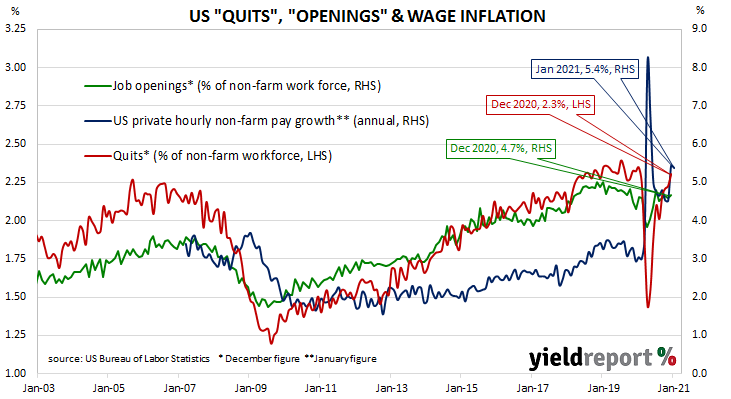Summary: US quit rate rises in December; job openings up, total separations down; higher job openings “normally associated with expanding economy”.
The number of US employees who quit their jobs as a percentage of total employment increased slowly but steadily after the GFC. It peaked in March 2019 and then tracked sideways until virus containment measures were introduced in March 2020. The quit rate plummeted as alternative employment opportunities rapidly dried up but then recovered quite quickly over the remainder of 2020.
Figures released as part of the most recent JOLTS report show the quit rate ticked up in December following three months of unchanged readings. 2.3% of the non-farm workforce left their jobs voluntarily, a slightly higher rate than November’s 2.2%. The largest source of additional quits arose from the “Accommodation and food services”, accounting for around 45% of the increase, while the “Professional and business services” sector experienced the greatest reduction. Overall, the total number of quits for the month increased by 106,000 from November’s revised figure of 3.180 million to 3.286 million.

April’s non-farm payroll report indicated average hourly pay had spiked in that month, possibly the result of fewer lower-paid jobs relative to higher paying ones. Subsequent months’ figures then saw falls in average hourly pay, with a corresponding fall in the annual growth rate from 8.0% in April to 4.4% in November. It has since picked up to 5.4% in January.
Total vacancies at the end of December increased by 74,000, or 1.1%, from November’s revised figure of 6.572 million to 6.646 million, driven by a 296,000 rise in the “Professional and business services” sector. 76,000 fewer openings in the “Accommodation and food services” sector provided the single largest offset. Overall, 7 out of 18 sectors experienced more job openings than in the previous month.
Total separations during the same period declined by a net 63,000, or 1.1%, from November’s revised figure of 5.523 million to 5.460 million. The fall was led by the “Federal Government” sector, where there were 86,000 fewer separations than in November. Separations decreased in 10 out of 18 sectors.
ANZ senior economist Catherine Birch said the growing number of job vacancies was “a development normally associated with an expanding economy.”

